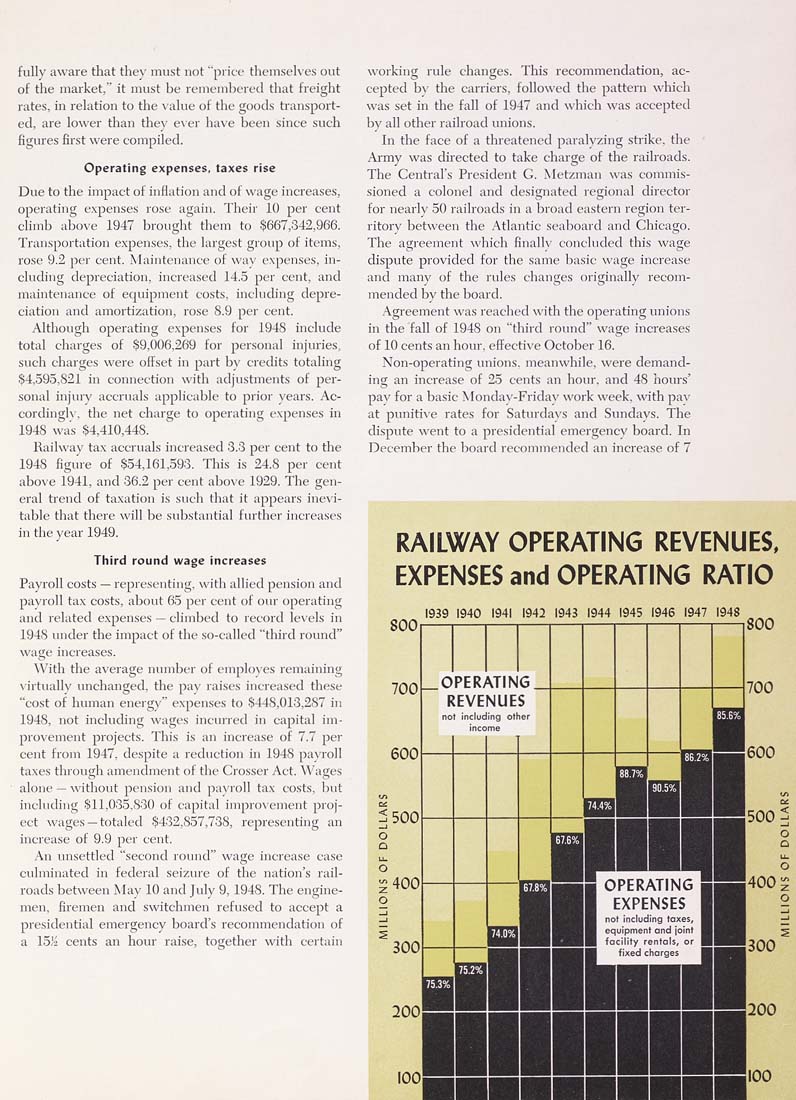fully aware that they must not "price thcmseK'cs out
of the market," it must be remembered that freight
rates, in relation to the value of the goods transport¬
ed, are lower than they e\er have been since such
figures first were compiled.
Operating expenses, taxes rise
Due to the impact of inflation and of wage increases,
operating expenses rose again, Theii' 10 per cent
climb above 1947 brought them to $667,342,966.
Transportation expenses, the largest group of items,
rose 9.2 per cent. Maintenance of way expenses, in¬
cluding depi"eciation, increased 14.5 per cent, and
maintenance of equipment costs, including depre-
ciatioT\ and amortization, rose 8.9 per cent.
Although operating expenses for 1948 include
total charges of $9,006,269 for personal injuries,
such charges were offset in part by credits totaling
$4,595,821 in connection with adjustments of per¬
sonal injury accruals applicable to prior years. Ac-
cordinglv, the net charge to operating expenses in
1948 was $4,410,448.
Railway tax accruals increased 3.3 per cent to the
1948 figure of $54,161,593. This is 24.8 per cent
above 1941, and 36.2 per cent above 1929. The gen¬
eral trend of taxation is such that it appears inevi¬
table that there will be siiljstantial fintluT incica.scs
in the year 1949.
Third round wage increases
Payroll costs — representing, with allied pension and
pavroU tax costs, about 65 per cent of our operating
and related expenses — climbed to record levels in
1948 inider the impact of the so-called "third round"
wage increases.
With the average number of cmpUnes remaining
\irtuallv unchanged, the pay raises increased these
"cost of human energy" expenses to $448,013,287 in
1948, not including wages incurred in capital ini-
pi'ovement projects. This is an increase of 7.7 per
cent from 1947, despite a reduction in 1948 payroll
taxes through amendment of the Crosser Act. Wages
alone — without pension and payroll tax costs, but
including $11,035,830 of capital improvement proj¬
ect wages-totaled $432,857,738, representing an
increase of 9.9 per cent.
An unsettled "second round" wage increase case
culminated in federal seizure of the nation's rail¬
roads between May 10 and July 9,1948. The engine-
men, firemen and switchmen refused to accept a
presidential emergency board's recommendatioTi of
a 15,'2 cents an hour raise, together with certain
w^orking rule changes. This recommendation, ac¬
cepted by the carriers, followed the pattern which
was set in the fall of 1947 and which was accepted
by all other railroad unions.
In the face of a threatened paralyzing strike, the
Army was directed to take charge of the railroads.
The Central's President C. Metzman was commis¬
sioned a colonel and designated regional director
for nearly 50 railroads in a broad eastern region ter¬
ritory between the Atlantic seaboard and Chicago.
The agreement which finally concluded this wage
dispute provided for the same basic wage increase
and many of the rules changes originally recom¬
mended by the board.
Agreement was reached with the operating unions
in the fall of 1948 on "third round" wage increases
of 10 cents an hour, effective October 16.
Non-operating unions, meanwhile, were demand¬
ing an increase of 25 cents an hour, and 48 hours'
pay for a basic Monday-Fridav work week, with pav
at punitive rates for Saturdavs and Simdays. The
dispute went to a presidential emergency board. In
December the board recommended an increase of 7
RAILWAY OPERATING REVENUES,
EXPENSES and OPERATING RATIO
1939 1940 1941 1942 1943 1944 1945 1946 1947 1948
8001------1-------1------1-------1-------1------1------1-------1-------1------1800
|








